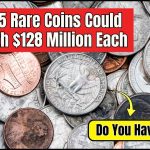5 Rare Finds: Imagine finding a coin in your pocket worth millions of dollars. Sounds unbelievable, right? Yet, rare coins have set record-breaking prices at auctions, sometimes fetching more than luxury cars or even mansions. These coins aren’t just pieces of metal—they’re treasures filled with history, rarity, and value.

Coins have fascinated people for centuries, not only for their face value but also for their historical significance and artistic craftsmanship. Collectors and investors alike chase after these rare pieces, hoping to uncover a hidden fortune. The rarest coins are often linked to significant events in history, making them priceless artifacts that reflect the economic and political landscapes of their time.
If you’re a collector, investor, or just curious about valuable coins, this article will introduce you to five of the rarest coins ever sold, explain why they’re worth so much, and guide you on how to identify valuable coins in your own collection.
5 Rare Finds
| Coin Name | Auction Price | Year Sold | Rarity & Significance |
|---|---|---|---|
| 1933 Double Eagle | $18.9 million | 2021 | One of the last gold coins before the Gold Reserve Act |
| 1794 Flowing Hair Silver Dollar | $10 million | 2013 | The first silver dollar issued by the U.S. Mint |
| 1913 Liberty Head Nickel | $3.7 million | 2010 | Only five specimens known to exist |
| 1787 Brasher Doubloon | $9.36 million | 2021 | The first gold coin struck in the U.S. |
| 1855-S Three-Dollar Gold Piece | $2.1 million | 2023 | Rare gold coin minted during the California Gold Rush |
Rare coins aren’t just fascinating—they’re historical artifacts and valuable investments. Whether you’re an investor, collector, or just someone who enjoys history, keeping an eye on rare coins can be both rewarding and profitable.
If you think you have a valuable coin, start by checking its date, mint mark, and condition, then get it professionally appraised. You never know—you might be holding a million-dollar treasure in your hands!
Why Are Some Coins Worth Millions?
Rare coins achieve high auction prices due to several key factors:
1. Historical Significance
Coins tied to major historical events, such as the Gold Reserve Act of 1934, which led to the destruction of many gold coins, are more valuable. The 1933 Double Eagle is a prime example.
Throughout history, various coins have served as symbols of wealth and power. Whether they were minted during wars, economic shifts, or for special commemorations, their importance elevates their worth far beyond their metal content.
2. Limited Supply & Rarity
The fewer coins available, the more collectors and investors are willing to pay. The 1913 Liberty Head Nickel, with only five known examples, is highly desirable. Many valuable coins were either melted down, lost, or had limited production, making their surviving pieces incredibly sought-after.
3. Condition & Grading
Coins are graded on a scale of 1-70. The higher the grade (closer to 70), the better the condition and the higher the value. Factors like scratches, discoloration, and wear play a huge role in determining a coin’s final price.
4. Demand from Collectors & Investors
Collectors seek historically significant coins, while investors treat rare coins as alternative investments, much like art or real estate. Some wealthy collectors acquire rare coins as a means of preserving wealth, much like gold bars or fine art.
The 5 Most Expensive Coins Ever Sold
1. 1933 Double Eagle – $18.9 Million
This gold coin was never officially released due to the Gold Reserve Act, making it extremely rare. Only one legal specimen remains in private hands, setting the record for the highest price ever paid for a coin.
2. 1794 Flowing Hair Silver Dollar – $10 Million
As the first silver dollar minted in the United States, this coin is a piece of American history. Experts believe it may have been personally examined by George Washington. This rare piece represents the birth of the American monetary system.
3. 1913 Liberty Head Nickel – $3.7 Million
This coin wasn’t officially minted, but a few specimens were mysteriously produced. It’s now one of the most sought-after nickels in history. Many speculate about the secrecy surrounding its production, adding to its allure.
4. 1787 Brasher Doubloon – $9.36 Million
This privately minted gold coin was created by goldsmith Ephraim Brasher, a friend of George Washington. Its historical value and gold content make it a collector’s dream. The intricate design and craftsmanship further enhance its appeal.
5. 1855-S Three-Dollar Gold Piece – $2.1 Million
Minted during the California Gold Rush, this coin is one of the rarest gold pieces ever made, making it incredibly valuable to collectors. Many gold rush-era coins were heavily circulated, making high-grade examples especially rare.
How to Identify a Valuable Coin in Your Collection
If you’re wondering whether you have a hidden fortune in your collection, follow these steps:
1. Check the Date & Mint Mark
- Coins with unusual dates (like 1913 for a Liberty Nickel) or rare mint marks (like the 1855-S Three-Dollar Gold Piece) tend to be valuable.
2. Inspect the Condition
- Higher grades mean higher values. Use a magnifying glass to check for scratches, wear, and other imperfections.
3. Research the Coin’s History
- Visit reliable sites like NGC Coin or PCGS for valuation information.
4. Get a Professional Appraisal
- If you suspect a coin is valuable, get it graded by a professional service like PCGS or NGC.
$450 Million For 3 Rare Dimes and Bicentennial Coins – Do You Own One?
These 6 Rare Coins Valued at $2 Billion Each – Do You Have One?
Are You Holding a $70 Million Fortune? These Rare Coins Could Be Hiding in Your Collection!
Frequently Asked Questions About 5 Rare Finds
Q1: Can I find rare coins in circulation?
Yes! While million-dollar coins are rare, you can still find valuable coins in pocket change, such as error coins or old wheat pennies.
Q2: How can I sell a valuable coin?
Auction houses like Heritage Auctions or Stack’s Bowers are great places to sell rare coins.
Q3: What’s the best way to store valuable coins?
Use coin holders or airtight capsules to protect them from scratches and oxidation.
Q4: Are gold coins a good investment?
Yes, gold coins have intrinsic value and tend to appreciate over time, especially rare ones like the 1933 Double Eagle.











